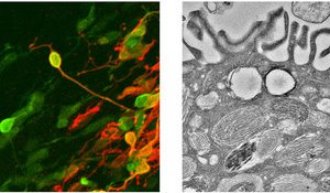Jun. 6, 2008 Research Highlight Biology
Replacement rods and cones
The generation of photoreceptors derived from embryonic stem cells may lead to new therapies for retinal diseases
 Figure 1: Photoreceptor cells (left) and retinal pigment epithelial cells (right) differentiated from human ES cells. Reproduced from Ref. 1 © 2008 Nature Publishing Group
Figure 1: Photoreceptor cells (left) and retinal pigment epithelial cells (right) differentiated from human ES cells. Reproduced from Ref. 1 © 2008 Nature Publishing Group
Japanese researchers have succeeded in generating photoreceptor cells from mouse, monkey and human embryonic stem (ES) cells using specific in vitro cell culture conditions1.
The team, led by Masayo Takahashi at the RIKEN Center for Developmental Biology in Kobe, initially developed a method for generating the rod and cone photoreceptors from mouse ES cells using a so-called ‘floating culture’ where the stem cells were induced to differentiate into retinal progenitor cells by aggregation into floating clumps of cells in a serum-containing growth medium.
By culturing these progenitor cells with an inhibitor blocking a specific signaling pathway, Takahashi and colleagues were able to significantly increase the number of photoreceptor precursor cells and generate both cone photoreceptor- and rod photoreceptor-like cells. But the proportion of rod photoreceptors was much lower than that of cone receptors—about 5% and 20% of the total cells respectively. The low proportion of rod photoreceptors could be significantly increased to nearly half of the total number of photoreceptors by culturing the cells in the presence of a number of developmental factors including fibroblast growth factors, the sonic hedgehog protein, taurine and retinoic acid (vitamin A).
The cell culture method developed for mouse ES cells, however, had one major drawback: the use of fetal bovine serum in the culture medium. Using monkey ES cells, the floating cell culture system was adapted for photoreceptor differentiation using a serum-free, defined culture medium. Culturing the cells in the presence of two inhibitors blocking separate signaling pathways resulted in generation of retinal pigment epithelial (RPE) cells as well as neural retinal progenitor cells. Subsequently, culture of the neural retinal progenitors in the presence of both taurine and retinoic acid resulted in differentiation into the two photoreceptor types.
The same method was successfully optimized to generate photoreceptors and RPE cells from human ES cells (Fig. 1). Importantly, Takahashi and her colleagues showed that the photoreceptors generated by this method are similar to their in vivo counterparts both in morphology and expression of the genes required for light responses. But it remains to be seen whether the cells will be functional.
“We need to purify photoreceptors from human ES cells and establish transplantation methods for integrating photoreceptors into the host retina,” says Takahashi.
The technique holds promise for the development of clinical methods for transplantation therapies utilizing stem cell-derived photoreceptors or RPE cells for retinal disorders such as retinitis pigmentosa and age-related macular degeneration.
References
- 1. Osakada, F., Ikeda, H., Mandai, M., Wataya, T., Watanabe, K., Yoshimura, N., Akaike, A., Sasai, Y. & Takahashi, M. Toward the generation of rod and cone photoreceptors from mouse, monkey and human embryonic stem cells. Nature Biotechnology 26, 215–224 (2008). doi: 10.1038/nbt1384
